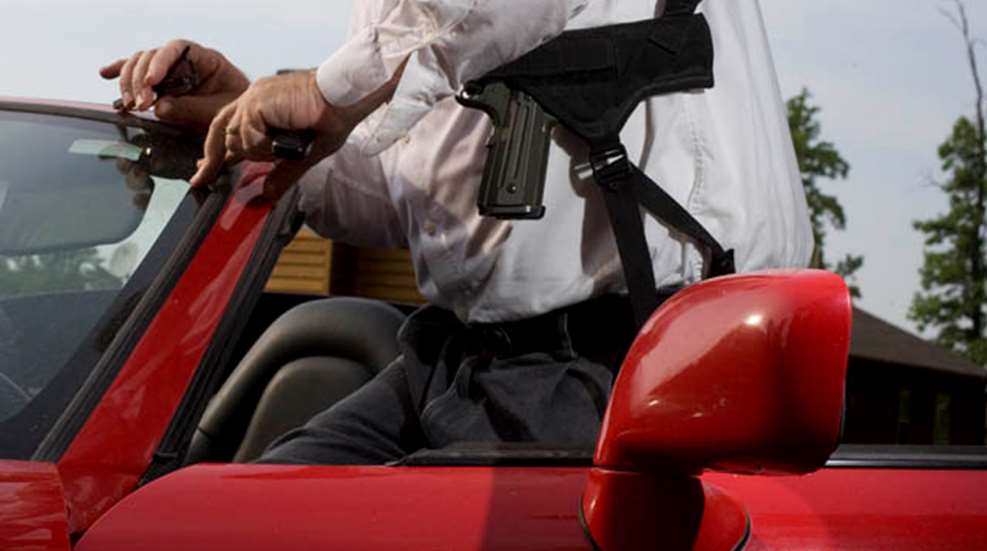
Regardless of who you are and what you do, we are all part of a mobile society. So unless you get everywhere by walking or peddling a bicycle (something we'll consider in a later chapter of this series), vehicular transport is one of the biggest activities we all share when it comes to legally carrying a concealed firearm. Driving your own car or traveling by public transportation present unique difficulties in concealing and producing a firearm for defense against a deadly force threat. But how do you do this in ways that not only don't tip your hand, but also allow you to get the gun into your hand if it is needed while you are aboard a vehicle?
Except for those instances when you find yourself having to stand in a crowded bus or train car, most of the time you will be in a seated position. Looking at the limited amount of space you really have inside of a car as either the driver or a passenger, or how you might find yourself wedged between a window and a fellow traveler on a bus or subway, it will generally be a very confined, seated position. To be honest, if there is nowhere to sit on the bus or train, more than likely you'll be standing shoulder-to-shoulder with other commuters in a confined manner, too.
So, that means carrying and producing the gun from the typical strong side, behind-the-hip location will be difficult, if not impossible. You will either be sitting on top of the gun or you will not have the space to get to it. An appendix carry might work if you are standing or seated alone in a public vehicle or motoring in a car, but having someone seated to your right (or being forced against a window, a sidewall or a console) leaves no room for your elbow as your wrist turns 90 degrees to your forearm and you attempt to grip and draw the firearm.
I'm the first one to emphasize the value of an ankle holster and to demonstrate drawing techniques for it that can be used while either sitting or standing, but I'll also tell you they won't be of much help in a crowd or if you're wedged into the often narrow, pew-like seating of a bus or train car. A personal car maybe, but even here, you must deal with a possibly confined space, as well as the limited amount of freedom afforded by the vehicle's seating restraints. And if you are the driver of that car, the steering wheel can be an impediment, too.
Therefore, we need to look for something that will work whether we are seated or standing (don't forget that you might need to access the gun while going to and from the vehicle itself) and we need to look at something that will not require your hands or arms to be extended beyond the outline of your body or the space it occupies within the vehicle in which you are traveling.
A cross-body design of some sort might make the most sense. By cross-body, I mean something worn on the non-dominant side, but is still drawn with the dominant hand. It could be something as specific as a vertical or a horizontal shoulder holster or as recognizable by name as a cross-draw holster. Perhaps the answer is one of the vertical belt or paddle holsters that can be positioned at a variety of locations along or around the waistband. In any case, the firearm needs to carried far enough to the side so it is not readily apparent to others through an open coat or other covering garment. And that garment needs to be considered as well; for it must be designed to allow access to a firearm carried in this manner. Finally, the holster would probably be best positioned no lower than the waist. This would allow the same holster to easily adapt to either a seated or a standing position.
Carried in this manner, a small to moderate-sized pistol or revolver can easily be reached by a hand folded across the chest or brought up from the lap while sitting, brought up even farther from alongside the body while standing, dropped down from an overhead position such as when holding a commuter strap or railing or swung over from a steering wheel or gearshift.
If, for any of a number of reasons, these conventional holsters cannot be used, unconventional options abound. A belly band worn high on the torso might work under a shirt in warmer weather or when coats and jackets might be out of place. A discrete fanny pack (more like the utility belt packs that have become common in recent years) can be worn almost unnoticeably on the belt and positioned somewhere between the naval and the non-dominant hip. Be careful to make sure the pack is discrete enough to avoid becoming a "shoot me first" pack, though.
Are there drawbacks to such a method of carry? Yes, but as I always say in my classes, you don't get something for nothing. Everything in this business is a trade-off and the idea is to minimize the drawbacks and maximize the potential. The biggest issue here is the move away from a straight-line presentation of the gun to the threat. It requires practice and constant awareness, for it doesn't build on most of our training. There is some concern over an adversary pinning the strong hand to the chest and preventing the muzzle from bearing on the threat at all. But considering how such firearms are carried (hidden from those around you) and employed (only as means of dealing with a deadly force threat), the gun is generally produced and put into action before the threat is made aware of them.






































